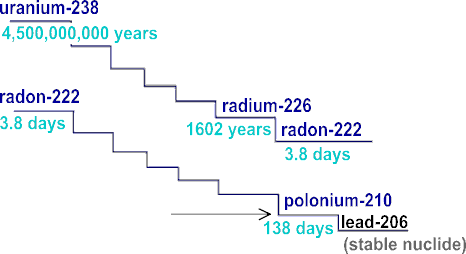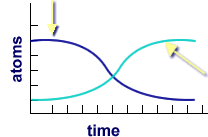Decay Chains
Radiation and Radioactivity
Most naturally occurring radioactive materials and many fission products; undergo radioactive decay through a series of transformations rather than in a single step. Until the last step, these radionuclides emit energy or particle with each transformation and become another radionuclide. Man-made elements, which are all heavier than uranium and unstable, undergo decay in this way. This decay chain, or decay series, ends in a stable nuclide.
On this page:
- Uranium Decay Chain
- The Importance of Radionuclide Decay Chains
- Ingrowth
- How do scientists know how much radioactivity there will be?
- Radon ingrowth during uranium decay
For example, uranium-238 decays through a series of steps to become a stable form of lead. Each step in the illustration below, indicates a different nuclide. Only a few of the steps are labeled, and the numbers below each label indicate the length of the particular radionuclide's half-life. Uranium-238 has the longest half-life, 4.5 billion years, and radon-222 the shortest, 3.8 days. The last radionuclide in the chain, polonium-210 transforms to lead-210, and eventually the stable nuclide, lead-206.
Uranium-238 Decay Chain

The Importance of Radionuclide Decay Chains
Radionuclide decay chains are important in planning for the management and disposal of radioactive materials and waste and for site cleanup. As radioactive decay progresses, the concentration of the original radionuclides decreases, while the concentration of their decay products increases and then decreases as they undergo transformation.
Ingrowth
The increasing concentration of decay products and
activity is called ingrowth. The illustration below
shows ingrowth when the decay product is stable and
the original radionuclide is replaced. In this situation,
the activity decreases with decay of the original
radionuclide.
decreases as radioactive decay progresses.

If the decay products are not stable, their decay contributes to the total activity and makes planning for radiation protection more complex.
In the case of a radioactive waste repository, the mix of radionuclides in the waste will change over time.;The amount of radiation being released can actually rise over time as successive radioactive decay products undergo decay. The radiation protection standards set for a repository must take into account varying levels of radioactivity as successive iterations of radionuclide ingrowth take place, even though the process continues over thousands of years.
How do scientists know how much radioactivity there will be?
The pattern of ingrowth varies according to the relative length of the half-lives of the original radionuclide and its decay products. Under certain conditions, decay products undergo transformation at the same rate they are produced. When this occurs, radioactive equilibrium is said to exist. Whether equilibrium occurs depends on the relative lengths of the half-live of radionuclides and their decay products.
Using equations that account for half-lives, the rate of ingrowth, whether equilibrium occurs, the original amount of radionuclide, and the steps in its decay chain, scientists can estimate the amount of activity that will be present at various points.
Radon ingrowth during uranium decay
The importance of understanding decay chains is illustrated by the ingrowth of radon-222 during decay of uranium-238. Uranium was distributed widely in the earth's crust as it formed. Given the age of the earth, uranium's slowly progressing decay chain now commonly produces radon-222.It is radioactive and has several characteristics that magnify its health effects:
- Radon is a gas. It can seep through soil and cracks in rock into the air. It can seep through foundations into homes (particularly basements), and accumulate into fairly high concentrations.
- Radon decay emits alpha particles, the radiation that presents the greatest hazard to lung tissue.
- Radon's very short half-life (3.8 days) means that it emits alpha particles at a high rate.
During exposure assessments, we pay close attention to the potential for radon generation. In designing cleanup standards for uranium mill tailings sites, we targeted radium-226, which decays to radon-222, rather than the radon-222 alone. The radium-226 continue to generate radon-222 during its much longer half-life.
Radon and uranium miners
A higher than expected level of lung disease in uranium miners helped call attention to the effects of radon-222. The miners worked long hours in enclosed spaces, surrounded by uranium ore and radon that seeped out of the rock. Health workers expected to see health problems in the miners that would reflect direct exposure to radiation. Instead, the predominant health problems were lung cancer and other lung diseases.
First the health workers suspected the dust itself. They knew that high concentrations of small particles, such as coal dust, asbestos, or cotton fibers, could damage workers' lungs. However, close examination of the uranium-238 decay chain identified radon-222 as the most likely culprit.
This led to regulations in two areas:
- improved ventilation in uranium mines and
- limits on the amount of radon ventilated from the mines to the ambient air.
![[logo] US EPA](https://webarchive.library.unt.edu/eot2008/20081110234910im_/http://www.epa.gov/epafiles/images/logo_epaseal.gif)